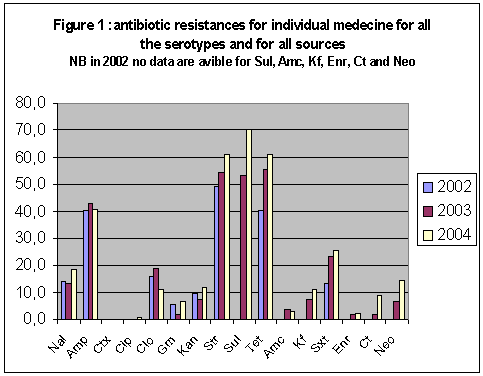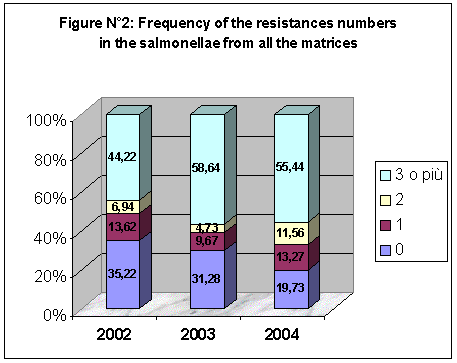Istituto Zooprofilattico Sperimentale dell'Umbria e delle Marche
Webzine Sanità Pubblica Veterinaria - Dicembre 2004. Numero 28 [http://www.izsum.it/webzine.html]
Antibiotic resistance trend and analysis of salmonella enterica isolates between 2002-2004 in Marche region - Italy
M. Staffolani, E. Micci, G. Striano, G. Perugini and S. Fisichella
Centre of Regional Reference for the Enteropathogens, Istituto Zooprofilattico Sperimentale Umbria Marche, Sezione di Macerata
INTRODUCTION
Antibiotic resistance is increasing worldwide and is becoming frequent in bacterial genera as Staphilococcus, Enterococcus, Streptococcus, Shigella, Mycobacterium and Salmonella (1). Resistance to expanded-spectrum cephalosporin among Salmonella isolates has been reported (2-5).
The aim of this study was to investigate the trend of antibiotic resistance of 1180 Salmonella isolates collected by the Centre of Regional Reference for the Enteropathogens between 2002-2004.
The serotype and antimicrobial susceptibility of Salmonella strains isolated from humans, foodstuffs, environment and farm animals were examined. Our data were processed to put in evidence significant antibiotic resistance changes to single antimicrobials and the trend of some important resistant serotypes as Salmonella Typhimurium DT104 (6 ,7 ,8) and Salmonella [4,5,12:i:-].
MATERIALS and METHODS
The serotyping was performed using commercial serum (Statens Serum Institut-Biogenetics Denmark), while the antimicrobial susceptibility testing was carried out according to the disk diffusion technique of the NCCLS guidelines (9).
The human strains were tested for 13 antibiotics at the following concentrations: Ampicillin (A) 10, Chloramphenicol (C) 30, Streptomycin (S) 10, Sulfonamides (Su) 300, Tetracycline (T) 30, Nalidixic acid (Nal) 30, Cefotaxime (Ctx) 30, Ciprofloxacin (Cip) 5, Gentamicin (Gm) 10, Kanamycin (Kan) 30, Amoxycillin clavulanic acid (Amc) 30, Trimethoprim-Sulfamethoxazole (Sxt) 1.25/23.75 and Cefalotin (Kf) 30. Three other antibiotics, Colistin (C1) 10, Enrofloxacin (Enr) 5 and Neomycin (Neo) 30 were tested for non human strains.
STRAINS
|
Table N°1 Total number of Salmonella strains received divided by source of isolation and by year (the gathering of the environmental strains started in 2003; the 2004 data refer to the January-September period) |
| Year | Isolated Salmonellae from human | Isolated Salmonellae from animals | Isolated Salmonellae from food | Isolated Salmonellae from environment | Total |
| 2002 | 273 | 41 | 86 | - | 400 |
| 2003 | 340 | 30 | 64 | 52 | 486 |
| 2004 | 203 | 32 | 33 | 26 | 294 |
| Total | 816 | 103 | 183 | 78 | 1180 |
RESULTS
Antibiotic resistance in Salmonella isolates collected between 2002 and 2004 is shown in Figure 1. Fluoroquinolones and cephalosporins of the III generation are the only treatment for antibiotic-resistant systemic salmonellosis. Since fluoroquinolones have serious side effects, the only possible treatment in children is represented by a cephalosporin of III generation, commonly known as ceftriaxone.
Resistance to ciprofloxacin and cefotaxime was not detected in isolates collected in 2002 and 2003, but resistance to ciprofloxacin, the most widely used among fluoroquinolones, appeared in isolates collected in 2004 (Figure 1).
Increasing in antibiotic resistance was found to Tetracycline and Trimethoprim-Sulfamethoxazole in 2002-2003, and to Streptomycin, Sulfonamides and Tetracycline in 2003-2004.
MULTIRESISTANCE ANALYSIS
Resistance equal or higher to 3 antibiotics is defined in this study as "multiresistance".
A general multiresistance increase in all isolates was detected between 2002 and 2003 (from 44.22 to 58.64) which remained about at the same level in 2004.
It is to remark the negative trend of sensible strains ("0" category) that make the resistance categories more and more numerous.
TREND OF SOME MULTIRESITANT SEROTYPES
It has been possible to investigate the progress of some antibiotic resistance profiles (resistotypes) particularly widespread in some serotypes in 2003-2004.
Strains of human origin of Typhimurium serotype had a high frequency of resistotypes ASSuT/ACSSuT (Ampicillin, Chloramphenicol, Streptomycin, Sulfonamides, Tetracycline) often associated with Nal, Sxt, Kf and Amc. In fact in 2003 on 121 strains of human origin of Typhimurium serotype, 93 (77%) have shown multiresistance and, amongst these, the 77% have one of the two resistotypes mentioned above.
Futhermore, in 2004 this trend increased because of 56 human Typhimurium strains 53 were multiresistant and of these 46 were of ASSuT/ACSSuT resistotypes. Of note, most of Typhimurium isolates of ASSuT/ACSSuT resistotypes are of DT104 phagetype, an important pandemic strain characterized by multiresistance (6, 7, 8).
Also the monophasic Salmonella [4,5,12:i:-] had the two resistotypes in a high frequency. In fact the 29 strains isolated in 2003 (25 from human source and 4 from food source) were all multiresistant and the greater part has the ASSuT profile often associated with other antibiotics and the 43 strains isolated in 2004, all of human origin, show a similar situation.
DISCUSSION
Animals bred for food purposes are a wide reserve for the antibiotic-resistant bacteria and food of animal origin can be a vector of human transmission (10).
From the data presented in this work concerning the region Marche, it clearly emerges that the antibiotic resistance problem isn't under control since resistances are generally increasing. Furthermore resistances to some antibiotics of the latest generation are also increasing (Nalidixic acid, Ciprofloxacin).
In our opinion, then it is desirable and necessary to implement the surveillance systems and to deliver guidelines for cautious use of antibiotics in both veterinary and clinic fields.
BIBLIOGRAFIA
- 1Davies JE (1998) in: "Antibiotic Resistance: Origin, Evolution, selection and Spread"; Ciba Foundation Symposium 207, Wiley, Chichester, pp. 15-27).
- Reyna F et al. (1995) Antimicrobial Agents and Chemotherapy 39, 1621-23.
- Griggs DJ et al. (1996) Antimicrobial Agents and Chemotherapy 40, 1009-13.
- Piddock LJV et al. (1998) Antimicrobial Agents and Chemotherapy 41, 635-641.
- Fey PD, Safranek TJ, Rupp ME, et al. N Engl J Med. (2000) Apr 27; 342 (17): 1242-9.
- Glynn MK, Boop C, Dewitt, W. et al. (1998). New England Journal of Medicine 338, 1333-8.
- Low, GC, Angus M, Hopkins G. et al. (1997). Epidemiology and Infection 118, 97-103.
- Poppe C., Smart N., Khakhria R. et al. (1998). Canadian Veterinary Journal 39, 559-65.
- National Committee for Clinical Laboratory Standards. (2000) 7th ed., M2-A7.
- Van den Bogaard AE et al. Int J Antimicrob Agents (2000), 14, 327-35.


